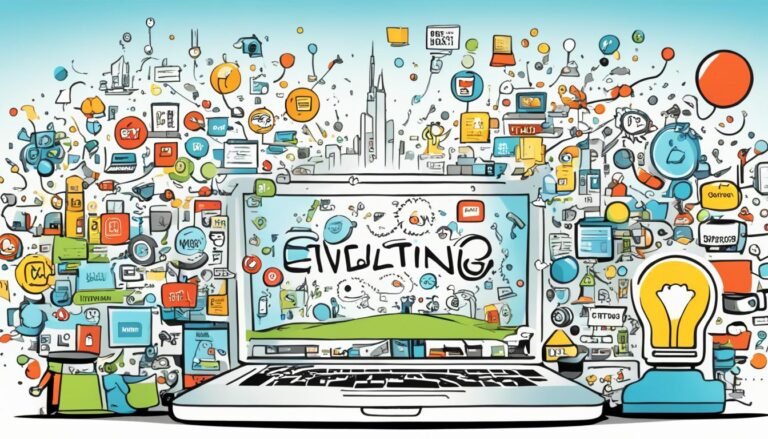Relationship Marketing: Building Strong Customer Bonds
Did you know that engaged customers tend to spend over 23% more than disengaged customers? This shows how important Relationship Marketing is. In today’s competitive world, building strong Customer Relationships is key for growth. Using CRM Strategies helps businesses keep customers coming back and stay successful over time.
Key Takeaways
- Engaged customers spend 23% more than disengaged ones.
- CRM adoption benefits businesses of all sizes, including small enterprises.
- AI and IoT are transforming CRM with real-time and predictive insights.
- Relationship marketing fosters genuine and lasting bonds with customers.
- Companies investing in relationship marketing achieve higher ROI.
- 85% of companies consider long-term customer relationships critical.
- 47% of customers regularly buy from brands that support a good cause.
Understanding Relationship Marketing
Relationship marketing is all about building long-term connections with customers. It’s not just about making quick sales. By focusing on building customer bonds, companies can see big benefits. These include more loyal customers, higher customer lifetime value (CLV), and better profits over time.
Definition and Importance
This approach means doing things that create strong emotional ties with customers. These ties lead to more business and word-of-mouth. By focusing on personalized customer relationships, companies can meet individual customer needs better. This makes customers happier and more likely to stay with the brand.
Companies like American Express and Delta Airlines are great examples. They use special loyalty programs and top-notch customer service to keep customers coming back.
Differences Between Transactional and Relationship Marketing
Transactional marketing is all about making one sale at a time. It doesn’t think about keeping customers for the long haul. On the other hand, relationship marketing is all about building lasting relationships with customers.
This approach is key to getting customers to stick around and come back. It’s about building trust and getting repeat business. Using Customer Relationship Management (CRM) tools and strategies helps make customers feel important and understood.
Companies that focus on relationship marketing often end up with customers who are true brand fans. These customers help spread the word without needing big ad campaigns. It’s all about making customers feel special and valued.
The Significance of Building Strong Customer Bonds
Creating strong bonds with customers is key to keeping them loyal and retaining them. This approach goes beyond just selling things. It’s about making emotional connections and building trust with your brand. Let’s look at why strong customer bonds are so important:
Customer Loyalty and Retention
Customer Loyalty Programs are a great way to keep customers coming back. Studies show that selling to an existing customer has a 60-70% chance of success, compared to just 5-20% with new customers. Happy customers spend more and are less likely to leave for the competition. Plus, improving retention by 5% can boost profits by about 25%.
It costs five times more to get a new customer than to keep an old one. So, keeping current customers happy is crucial and cost-effective. Yet, 44% of companies focus more on getting new customers than on keeping the ones they have.
Emotional Connection and Trust Building
At the heart of Emotional Branding is creating a bond with consumers. Trust in a brand can greatly increase customer loyalty. Apple and Nike are great examples of this. They use innovative products and stories that touch people’s hearts.
These emotional connections make customers loyal and even advocates for the brand. They talk positively about the brand and spread the word. Since unhappy customers can tell up to 13 people about bad experiences, it’s crucial to keep the emotional connection positive.
In the end, building trust and an emotional bond with customers is more than just keeping them loyal. It’s about turning them into lifelong supporters who care deeply about your brand’s success.
Strategies for Effective Relationship Marketing
Building strong customer bonds is key for businesses. They should offer a personalized experience and gather feedback. This approach creates deeper connections and lasting relationships with customers.
Personalization and Customer Experience
Using Marketing Personalization Techniques can greatly improve the Customer Experience Optimization. Companies like Amazon and Netflix show how to make content fit what each customer likes. They make the journey smooth and personal for everyone.
CRM Personalization tools help understand what customers want and need. This makes interactions feel more personal. Customers who feel a strong connection with a brand are worth 52% more, which is a big deal for Customer Lifetime Value (CLV).
Creating Customer Feedback Mechanisms
It’s important to have a good Feedback Loop Implementation. Tools like surveys and interviews help get insights to improve services. Forbes says 91% of customers might switch brands to support ones that share their values.
This shows how crucial it is to know and meet customer expectations. Using feedback well can make products better and build trust. This leads to more loyal customers, which means less cost to keep them and more to keep them.
- Increased sales: Loyal customers buy more and come back often. This means more money and stability for the business.
- Boosted brand awareness: Happy customers tell others about the brand. This brings in new customers without extra cost and makes the brand look better.
The Role of Personalization in Customer Retention
In today’s market, companies use Personalized Marketing Campaigns to keep customers coming back. By making experiences unique, they build strong bonds with their audience. This leads to lasting relationships and fewer customers leaving.
Behavioral Targeting is key in making these personalized plans. It helps companies understand what customers like. This way, they can offer exactly what each customer wants.
Implementing Personalization Techniques
To keep customers, businesses use several smart ways:
- Relevant Content Dissemination: With Behavioral Targeting, companies send content that matches what customers are interested in. This makes customers more engaged and happy.
- Milestone Celebrations: Celebrating important events like anniversaries with special messages or deals makes customers feel special.
- Dynamic Emails: Emails that change based on what users like or do are more likely to lead to sales. They also make customers feel closer to the brand.
Companies like Amazon and Netflix are great at making marketing personal. They use data to give customers exactly what they want. This approach boosts customer loyalty and leads to more repeat business.
“Retaining existing customers is often more cost-effective than acquiring new ones. Therefore, developing strong, personalized relationships with customers is vital for long-term success.”
Using personalization is a big part of keeping customers happy and loyal. By doing this, businesses can see more loyalty, more money, and a better brand image.
Leveraging Data for Data-Driven Relationship Marketing
Data-driven relationship marketing is key in today’s market. CRM Systems are vital for using this data. They help businesses build strong, lasting customer ties. By using Customer Insights from CRM Systems, companies can make marketing that makes customers happier and more loyal.
Using CRM Technology
CRM Technology is crucial for modern Customer Relations. It gives the tools to collect and understand customer interactions. With these insights, businesses can make their marketing better and more effective.
To get the most from CRM Systems, businesses should focus on these strategies:
- Personalized Communication: By looking at Customer Insights, businesses can make their messages fit what each customer needs, making them more engaged.
- Loyalty Programs: Start loyalty programs that give rewards for buying again and make customers talk about your brand.
- Proactive Customer Service: Use Technology in Customer Relations to guess what customers need and solve problems before they happen.
- Data-Driven Segmentation: Sort customers by who they are, what they buy, and how they interact to send them targeted marketing.
- Social Media Engagement: Use social media to talk with customers, get feedback, and build a strong community around your brand.
Using these strategies can greatly improve how well customers stick around, make them happier, and increase what they spend over time. Good CRM Technology helps businesses gather and understand data. This gives a strong base for making marketing that works well.
Building Customer Loyalty Programs
Companies now see the value in Loyalty Program Development. They know it’s cheaper to keep customers than to find new ones. This makes loyalty programs key to growing a business.
Designing Reward Systems
A good reward system keeps customers coming back. Customers who return spend 67% more than new ones. This makes the Reward System ROI very attractive.
Rewards can be discounts, special product access, or unique experiences. Companies like Starbucks and Amazon Prime use these to build strong customer relationships. They track how customers interact with their rewards to keep them happy and loyal.
Measuring Effectiveness
It’s vital to see how well a loyalty program works. Metrics like customer retention and Reward System ROI guide improvements. A small increase in customer retention can lead to big profits, up to 95% more.
Listening to customers is also key. McKinsey found that most people in successful loyalty programs change their buying habits to help the business. Accurate tracking of loyalty helps make sure these programs work well and grow.
- 64% of customers in loyalty programs buy more often.
- 31% pay more because they feel valued by the brand.
- Getting new customers costs a lot more than keeping the ones you have, as studies by Gartner show.
In conclusion, Loyalty Program Development needs great rewards and careful tracking. Using important Loyalty Measurement Metrics and Tracking Customer Engagement can lead a business to success and profits over time.
The Power of Emotional Connection
Emotional connection plays a big role in how customers make decisions. Brands that use *emotional marketing* build stronger ties with their customers. This leads to *successful brand relationships*. Studies show that customers who feel a strong emotional bond with a brand are 52% more valuable.
How Emotions Influence Customer Decisions
When making choices, emotions guide consumers a lot. Ads that touch people’s feelings can increase sales by 23%. This shows how important it is to connect with people on an emotional level.
Research shows emotions play a big part in *customer decision-making*. They often take over logical thinking. Ads that focus on feelings do much better than those that don’t.
Case Studies of Successful Brands
Tesla and Nike are great examples of brands that use emotional connections well. Tesla makes people feel like they belong and are part of something new. Nike’s “Just Do It” campaigns motivate and keep customers loyal.
Research says 71% of customers recommend brands they feel a strong bond with. This shows how *emotional marketing* helps create loyal customers.
In short, brands that *connect with customers* emotionally improve their experiences and grow their businesses. They stay ahead in the market.
Utilizing Social Media for Relationship Marketing
Social media offers many ways to talk to customers and make marketing stronger. Companies can use these platforms to build real connections. This helps make customers more loyal and happy.
With social media, talking to customers in real-time is easy. This helps make their bond with the brand stronger.
Engagement Strategies
Good social media strategies can make customers more loyal and less likely to leave. Talking to customers in a friendly way, like using their names, makes them feel valued. It also makes their experience better.
Offering rewards and fun activities can get people excited about a brand. This can make them more loyal and spread the word about the brand.
Social Listening and Feedback
Tools for social listening help track what people are saying about a brand. This gives insights into what customers think. Brands like Starbucks use this to improve and build a community feel.
Using content made by customers can also help build a strong online community. It shows that a brand cares about what people think. Listening to customers and using their ideas can make them feel more connected to the brand.
Using social media for relationship marketing keeps customers happy and loyal. It helps businesses stay ahead of the competition. As talking and listening on social media becomes more important, using social media for marketing is key.
Source Links
- Customer Relationship Management: Building Strong Bonds with Your Customers
- Customer Relationship Marketing: Building Strong Connections
- Relationship Marketing: 5 Ways to Create Lifelong Customers
- What Is Relationship Marketing? | Definition from TechTarget
- Build Strong Bonds with Your Customers Via Relationship Marketing
- What is Relationship Marketing? Types & Real-Life Examples | Tipalti
- Why Build Customer Relationships: 4 Winning Reasons – Traffic Think Tank
- How to build customer relationships that earn trust, loyalty, and sales
- Relationship Marketing: Creating A Long-lasting Bond With Your Customer
- Customer Relationship Marketing: An Overview and 5 Effective Strategies – Influitive
- Building Customer Loyalty: Relationship Marketing for Sustainable Growth
- The Power of Relationship Marketing: How to Build Lasting Customer Connections
- The Power of Customer Relationship Marketing | Jebbit
- Effective Customer Relationship Management Strategies
- elaboratum | Profitable customer relationships through data strategy
- How to Build and Maintain Customer Loyalty | AdRoll
- Building Customer Loyalty in 10 Easy Ways
- The Power of Emotional Marketing: Connecting with Audiences
- The Power of Emotional Connection in Brand Building
- How to build customer relationships with social media
- What is Relationship Marketing & What are its Benefits?
- What is Relationship Marketing? (And How Do You Do It?)







